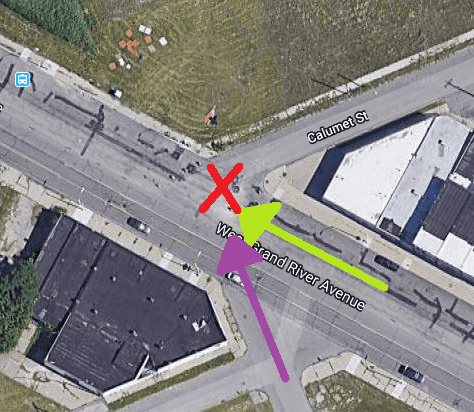This month, SEMCOG and its partners throughout the region are encouraging everyone in Southeast Michigan to stay safe on the roads and Walk.Bike.Drive. Safe. Safety is everyone’s responsibility. Today, Trevor Layton shares some information and tips specific to driving safely.
My first car was a rite of passage that signified the freedom and autonomy I had been longing for – and driving has been part of my life ever since. So I had somewhat of a surprise when I re-discovered the childhood joy of bicycling.
Though driving is often a luxury and sometimes a necessity, I now ride my bike to work whenever I can. In addition to the enjoyment, I can actually track some of the benefits via Commuter Connect. On any given day, riding my bike to and from work allows me to burn 1,000 calories, save more than a gallon of gas for my car, and reduce my greenhouse gas emissions by more than 20 pounds.
While biking has many advantages, safety is a concern. I am comfortable on my route, but the truth is that I am always just one mistake away (mine or someone else’s) from a deadly crash. A close call over the summer reminded me of this. I was riding home from work, traveling northwest along Grand River Ave. in a marked bicycle lane (Note: the Google Maps image below was captured before this bicycle lane was painted).

Green line = bicycle; purple line = automobile
As I was riding toward the intersection shown above, a car was crossing Grand River to turn onto Calumet St. Unfortunately, the driver was not looking for a cyclist and never saw me. They cut in front of me; I was not able to stop completely, and my bike crashed into the car’s rear quarter panel. While my bike was wrecked, I was fortunate to sustain only some scratches and bruising. My helmet did its job. The driver was very distraught and apologetic after our collision.
Unfortunately, this scenario is not unique:
50% of bicycle and pedestrian crashes occur at intersections.
My hope is that this driver now scans for all forms of traffic – motor vehicles, bicycles, and pedestrians – when crossing or turning through an intersection. The incident was frightening for both of us, and I know from my own experiences as a driver how scary it is to have a close call with a bike or pedestrian.
Fortunately, there are things all drivers and cyclists can do to prevent crashes. Earlier this week, Jenya Abramovich shared tips for people who ride bikes. Lights are an essential part of my riding setup, and I do my best to follow traffic laws and remain predictable when riding a bike.
There are also key things we can do as drivers to keep the roads safe. I encourage you to watch and share this video, which is one part of our Walk.Bike.Drive. Safe campaign. The video highlights the importance of turning safely at intersections.
Here are some more tips help you…
Drive Safe
Always…
- Watch for people who are walking and biking.
- Yield to people walking and biking when turning.
- Stop or yield to people within all crosswalks. Crosswalks exist wherever sidewalks cross roads, even if no lines are painted in the road.
- Share the road with bicyclists. They are legally allowed to ride on all roads, even when there is a bike lane or side path present.
- Leave at least 3 feet when passing bicyclists.
- Obey the posted speed limit.
Never…
- Block or park in crosswalks and bike lanes.
- Pass a vehicle that is stopped for pedestrians.
- Drive distracted, including talking or texting on your phone.
- Drive after consuming alcohol or drugs.

Leave a Reply